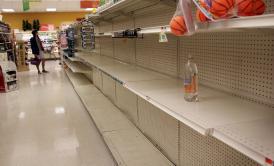UPDATE: Hurricane Sandy continues on its path north from the Caribbean to eventually cross paths with two other winter storms and cause the super storm or Frankenstorm that could be the biggest storm to ever hit the United States mainland, according to Reuters. Sandy could be felt over 800 miles “from the East Coast to the Great Lakes,” notes the Associated Press. “We’re looking at impact of greater than 50 to 60 million people,” Louis Uccellini, head of environmental prediction for the National Oceanic and Atmospheric Administration, tells the AP. Tens of thousands of people were ordered to evacuate coastal areas Sunday with Mayor Michael Bloomberg ordering evacuation of part of lower Manhattan and other low-lying neighborhoods.
The latest data has Sandy making landfall somewhere along the New Jersey coast very early Tuesday morning, reports USA Today. New York City announced its subway, bus, and railroad service would stop operating at 7 p.m. Sunday after the National Hurricane Center warned of “life-threatening” flooding along the Atlantic coast, reports the New York Times. Gov. Andrew Cuomo expressed hope that residents would take the cancellations as a sign that they shouldn’t be “up and about.” Sandy has killed at least 66 people in the Caribbean, including 51 in Haiti, notes Reuters.
Both presidential candidates were forced to cancel events as the impending storm scrambled carefully laid out campaign plans for the last stretch of the tight race. Mitt Romney traveled to Ohio Sunday instead of campaigning in Virginia as scheduled while Obama moved his planned Florida trip to Sunday night rather than Monday, reports the AP.
Saturday, October 27 at 1:27 p.m.: If you aren’t panicking yet, chances are you don’t live near the U.S. Eastern Seaboard. Residents in the most densely populated corridor in the country are stocking up on supplies and hunkering down for what is largely expected to be one of the worst storms in a generation. Hurricane Sandy had been downgraded to a tropical storm but upgraded once again Saturday morning. It is expected to make landfall on Monday night or Tuesday, although, as the Washington Post details, heavy rain could begin as early as Sunday afternoon. After the expected landfall near the Delaware coast, it will then hit two winter weather systems, giving rise to what the Associated Press calls a “hybrid monster storm.”
What the National Weather Service has dubbed “Frankenstorm” has been forcing the presidential campaigns to adjust travel schedules and cancel events as no one wants to give off the impression that politics comes before public safety, points out the AP. The storm could potentially have a direct impact on voting in some key states, including Virginia and Ohio, if there is lots of damage that continues to impact people’s lives by Election Day. And it could also affect polling, making it more difficult to get accurate data in the final 10 days of the election, points out Talking Points Memo.
The “super storm” will likely lead to strong winds, heavy rains, snow, and flooding to the mid-Atlantic, New England, and parts of the Midwest, details the Wall Street Journal. Millions could be left without power for a week and planes in the region will most likely be grounded, points out Bloomberg. The storm will be so huge that it will likely last two to three days and cover the eastern third of the United States. “The storm is so large the impact is going to be felt over hundreds of miles and many states at the same time,” a National Hurricane Center expert tells the New York Daily News.
Anyone watching TV over the past 48 hours knows full well how meteorologists have “exhausted a thesaurus full of superlatives trying to capture the potential magnitude of the unusual storm,” as the New York Times notes. While some might be tempted to interpret it as a lot of hype, the truth is that if the worst-case scenario models become a reality it will be “a storm of an intensity that we have not seen in this part of the country in the past century,” one National Weather Service meteorologist tells Bloomberg.
Sandy has been blamed for 41 deaths across the Caribbean, including 11 in Cuba, reports Reuters.
